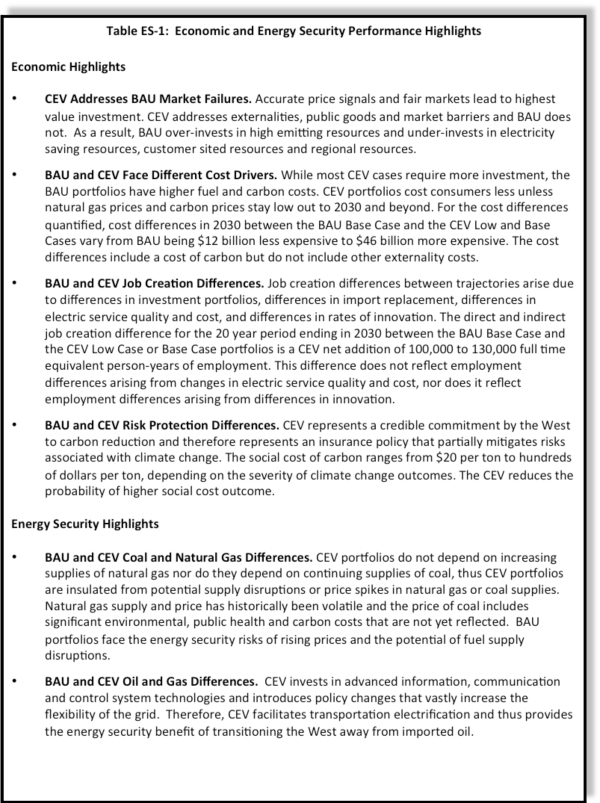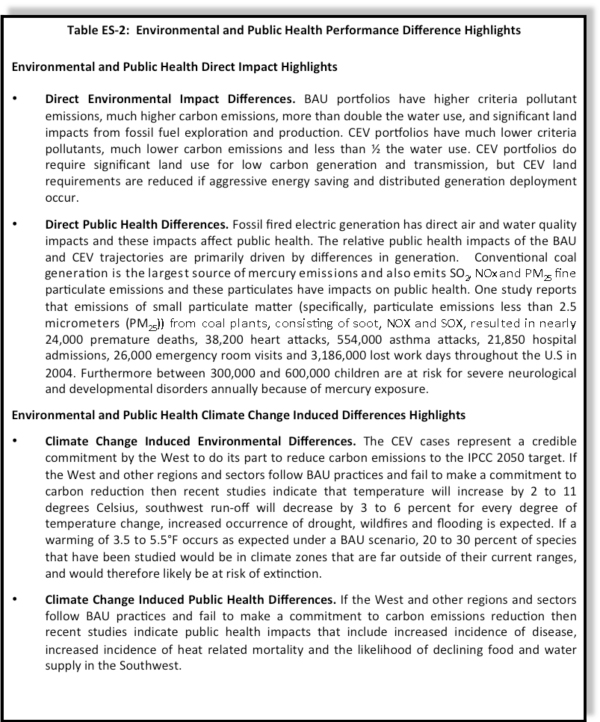Executive Summary
The western United States is at a crossroads. Wise electricity sector investment choices will lay the foundation for a robust, competitive and healthy West for generations to come. Unwise choices will leave western businesses at a competitive disadvantage in the global marketplace, western consumers with higher electricity bills and westerners of all walks of life with an unhealthy environment.
With the Western electricity sector investing more than $200 billion by 2030 regardless of the development path taken, the choices made will significantly affect quality of life in the West out to 2050 and beyond.[1] Significant investment will be required because coal, gas and nuclear facilities will need to be retired or replaced, population, economic growth, and electrification will drive gross electricity demand up, demand reduction efforts like energy efficiency programs will continue, new electric generation will be built and new transmission will be added. The question is not whether hundreds of billions will be invested but rather how they will be invested.
While existing renewable energy and energy saving statutory mandates will determine some investment choices, utilities and other electricity providers will recommend how the mandates are fulfilled and in where additional investment dollars are spent. These discretionary investment choices along with any new policy mandates will determine the direction and pace of grid evolution.
The policy and investment choices made could take the West in two very different directions. Western utilities and electricity providers may choose to operate the grid much as it is today and invest in refurbishing and expanding fossil generation, as well as building additional infrastructure to deliver fossil generated electricity. In other words, grid operation and expansion could follow a Business as Usual (BAU) trajectory.
Alternatively, policy makers and electricity providers may choose to modernize the grid and grid operations and focus their discretionary investment on information, communications and system control technologies that enable more energy saving, more low carbon energy production and more sophisticated grid operations. In other words, grid operations and expansion could follow a Clean Electricity Vision (CEV) trajectory.
If no choice is made, investment will be driven by inertia rather than intention and the grid of 2030 and 2050 will look very much like the grid of 2010. This report asserts that making an intentional choice between the BAU and CEV trajectories now is the responsible course of action.
Failure to make a wise, intentional choice now could saddle future electricity consumers with stranded costs, damage the natural environment, deprive job seekers of employment opportunities and leave western businesses with a grid that causes a competitive disadvantage in global markets. The choices made now will also affect the capacity of the West to reduce carbon emissions for decades to come – helping to do its part to meet the greenhouse gas goal recommended by scientists—80% reduction below 1990 levels by 2050.
Purpose of this Report
The purpose of this paper is to flesh out two contrasting views of the western electricity grid’s development trajectory from the present to 2050 and to evaluate the relative economic, environmental, energy security and public health consequences. The two trajectories presented are a BAU trajectory and a CEV trajectory.
The BAU trajectory focuses discretionary investment on retrofitting, repowering and adding coal generation and on meeting any incremental needs with new gas fired generation. The CEV trajectory focuses discretionary electricity resource investment on energy saving and renewable energy technologies. The two alternatives require different infrastructure, different grid operations, different grid planning and different utility regulation so an intentional choice between the two must be made.
The goals of the paper include: clarifying generation, infrastructure and institutional differences between the BAU and CEV futures, contrasting performance differences between futures and encouraging an open dialogue on electricity system investment priorities in the West.
The paper complements previous work in the western interconnection in two respects. First, placing 2020 electricity system development projections in the context of a 2050 development trajectory provides a perspective on long term infrastructure development needs. The insight gleaned is that efficient use of land requires that 2050 infrastructure needs be anticipated when planning for 2030.
Second, the analysis expands portfolio evaluation criteria from a short term cost focus to a long term evaluation of economic, environmental, energy security and public health consequences provides a more comprehensive look at performance differences. The insight gleaned is that focusing narrowly on one dimension of short term performance yields poor long term plans.
The study seeks to answer those questions that it can, but it also frames questions for further investigation where answers require more analysis, data and modeling.
Conditions of the Present and Contrasting Grids of the Future
The generation, infrastructure and institutions in the West today were selected based on limitations and assumptions of the past. The generation portfolio was selected based on the abundance of fossil resources, the absence of proven renewable energy technologies, and the absence of real time electronics to manage variable generation resources. The generation was also selected on the assumption that clean air, clean water and land were abundant and essentially free for the taking.
The West’s grid infrastructure, which includes its distribution, transmission and information systems, was selected to deliver base load electricity from large, remote coal, nuclear, hydro and natural gas generation fleet. Real time communications and system controls were not available and thus maintaining reliability required that system buffers be built in to allow for time consuming information exchange.
The West’s grid institutions, which include its grid operations, grid planning and utility regulation rules and regulations, were implemented in accordance with limitations imposed by out-dated information, communications and system control technologies. The regulatory institutions, by and large, were based on traditional rate of return regulation and did not reward utilities for resource saving investment.
While both the CEV and BAU trajectories require changes from the grid of the past, the CEV benefits more from maximum implementation of advanced infrastructure, information, communications and control technologies because the CEV assumes rapid evolution of grid rules, operations and planning.
The investment portfolio suggested by a CEV trajectory is different from the investment portfolio suggested by a BAU trajectory. First, net electricity demand is lower in the CEV due to more aggressive investment in electricity saving and distributed generation policies. Figure ES-1 contrasts the net electricity demand of the BAU and CEV trajectories from the present to 2050. Second, the generation portfolios selected to meet the respective net electricity demand needs is very different. Figure ES-2 shows the BAU Base Case generation portfolio and Figure ES-3 shows the CEV Base Case portfolio.
Figure ES-1: BAU vs. CEV Net Electricity Demand
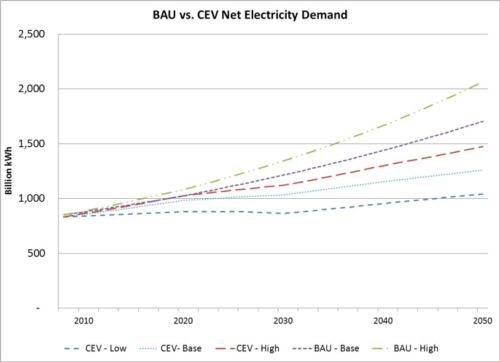
Figure ES-2: BAU Base Case Generation Portfolio
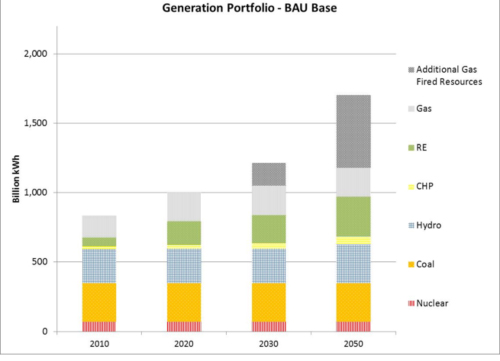
Figure ES-3: CEV Base Case Generation Portfolio
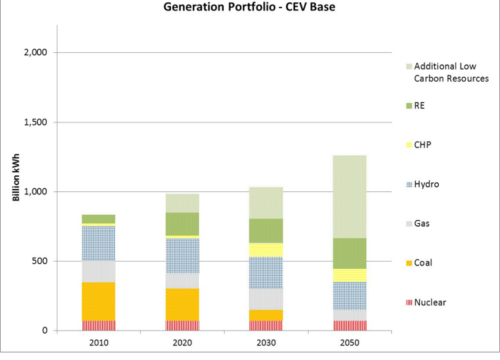
While both BAU and CEV trajectories presume growth in the renewable energy generation fleet due to enforcement of state mandated renewable energy standards, the CEV trajectory focuses its discretionary investment resources on energy saving and renewable energy technologies. The BAU trajectory focuses its discretionary financial resources on improving coal generation and building gas generation to meet emerging demand growth.
The infrastructure required by the CEV is also fundamentally different from the infrastructure required by the BAU. The CEV trajectory requires a western electricity infrastructure that includes transmission to access additional remote renewables, and information and control technologies that facilitate regional resources and demand side resources in meeting both reliability and energy needs. The BAU trajectory requires expanded transmission to deliver electricity from new gas fired resources and gas transmission infrastructure to serve expanded gas use, and it does not invest to facilitate demand side participation or regional cooperation.[2]
The institutional changes that are required to implement the BAU trajectory are also different from the institutional changes required to implement the CEV trajectory. The operation of the BAU grid would be very similar to the operation of the grid we have today so very few changes in operating rules and procedures would be expected. The CEV operation of the grid requires more regional cooperation and coordination among Balancing Areas (BA) and greater institutional flexibility to facilitate the best use of renewable energy resources in the West.
If an intentional choice is not made to transition toward infrastructure, institutions and investment choices that support a CEV trajectory, the inertia of conventional practice will lead to investment that builds a 2030 grid that looks very much like the grid of the last generation and a trajectory that looks like the BAU trajectory. Before allowing the BAU trajectory to be selected by default, it is appropriate to examine the relative performance of the BAU and CEV trajectories to ensure that hundreds of billions of investment dollars are not inadvertently wasted.
BAU and CEV Performance Differences
The research uses recent western interconnection modeling results and reviews a wide range of recent studies to characterize the BAU and CEV trajectories. The analysis then uses a simple model of the West and recent research results produced by others to identify differences in economic, environmental, energy security and public health performance between the trajectories.
The differences identified are substantial and presented in two parts. First, the differences that arise from the direct effects of the BAU and CEV development trajectories on economic, environmental, energy security and public health outcomes are presented. Table ES-1 on page 7 presents some highlights of the differences arising from these direct effects.
Second, differences in performance arising climate induced performance effects are considered. Since the CEV development dramatically reduces carbon emissions and the BAU development trajectory allows carbon emissions to grow, the two trajectories are very different in their contribution to addressing carbon accumulation in the atmosphere. While carbon emission reductions by other regions and sectors are necessary to affect global carbon accumulations, the CEV does its part to reduce its share of carbon emissions while the BAU does not. Therefore, the CEV can be thought of as an insurance policy against the potential negative consequences of climate change.
Table ES-2 below presents some highlights of the differences arising from climate induced effects.
A $200 Billion Decision
Regardless of whether a BAU trajectory or CEV trajectory is pursued, electricity sector investment required over the next twenty years will be more than $200 billion. With the majority of generation facilities being more than 30 years old, aging generation will need to be replaced. With incremental electricity need emerging, albeit for very different reasons (electricity demand growth in the case of BAU, coal plant retirement in the case of CEV), new generation, distribution and transmission facilities will need to be built to meet incremental need.
The facilities constructed will lay the foundation for electricity provision in the West to 2030, 2050 and beyond and thus will affect the economic, environmental, energy security and public health of the West for generations. Table ES-1 contrasts the BAU and CEV economic and energy security differences. Table ES-2 presents the environmental and public health performance differences.
The potential benefits of the CEV relative to the BAU trajectory can be considered in two parts. The tables of performance differences include differences that arise from the direct impacts of choosing different development trajectories. The performance differences also include differences that arise from climate change induced impacts. Qualitative and quantitative differences are included.
While scientific evidence is cited supporting the potential impacts of climate change, people from around the West disagree about the likelihood and severity of impacts. However, even if parties cannot agree on the question of expected likelihood and expected severity, parties should be able to agree on the range of potential outcomes. Therefore, as one evaluates the climate change differences between the BAU and CEV trajectories, one should consider the CEV to be an insurance policy against potential adverse consequences of climate change. If the western electricity sector fails to do its part to reduce carbon emissions, the likelihood that other sectors and regions will fail to do their part increases, and the likelihood of severe, negative outcomes decreases. Thus, while parties may disagree on the value of the CEV as an insurance policy, parties should be able to agree that such an insurance policy’s value is greater than zero.
A dialogue on alternative futures and the relative performance of alternative futures on a set of metrics that encompass economic, environmental, energy security and public health impacts is essential. Failure to explicitly choose an electricity sector trajectory for the West will allow the inertia of current business as usual practices to make the choice for us. The consequences of making the wrong choice are too great to leave the choice to inertia. This paper gets the discussion started by presenting BAU and CEV futures and presenting the relative direct and climate induced differences between the BAU and CEV futures.
[1] Chupka, et al. This Edison Electric Institute (EEI) funded study estimates that investment over the next two decades nationwide will be about $2 trillion for generation, demand reduction, transmission and distribution. The authors of the EEI study suggest the West accounts for about 15 percent of this investment then the western price tag would be about $250 billion. The business as usual portfolios developed in this paper show that even after the recession is taken into account more than $200 billion will be invested to build out a business as usual system.
[2] The BAU trajectory assumed here assumes coal generation facilities will not effectively control carbon emissions. Coal facilities cost examines cases where no carbon sequestration costs are incurred as well as cases where coal facilities are required to be carbon sequestration “ready.” Actually sequestering large amounts of carbon emissions has not been proven in practice and the cost of building an infrastructure to pipe carbon and store it safely is likely to be very expensive. The economic, environmental, energy security and public health consequences of failing to control carbon emissions are explored in the performance comparisons.
Executive Summary
Full report available HERE.
August 22, 2011
Prepared by:
Carl Linvill
John Candelaria
Ashley Spalding
Aspen Environmental Group for
The Clean Energy Vision Project
of Western Grid Group
